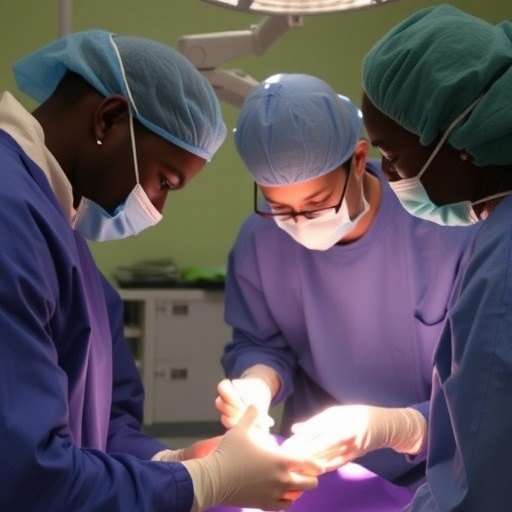In the evolving field of ophthalmology, cataract surgery remains a focal point for enhancing visual health. Recent research led by Ndayambaje et al. explores the implications of varying delivery models for cataract surgery within the framework of Rwanda’s National Eye Health Action Plan. This initiative not only aims to improve surgical efficiency but also recognizes the diverse healthcare delivery systems existing in the country. Given the escalating incidence of cataracts, understanding how these models work is crucial for public health strategies.
The study sets the stage by categorizing two primary models of cataract surgery delivery in Rwanda. The first model is hospital-based, where the surgical procedures are conducted in established medical facilities. This model benefits from infrastructure and trained personnel, which arguably enhances patient outcomes. The second model is a community-based approach, designed to increase accessibility and outreach, particularly in rural areas. This strategy seeks to address the geographical divide that often limits access to healthcare services.
One of the striking findings of this research is the patient demographics and socio-economic factors influencing the uptake of cataract surgery. Hospital-based models tend to cater predominantly to urban populations, while community-based initiatives reach those in remote locations. This disparity raises questions about equitable healthcare access and emphasizes the necessity for targeted educational campaigns aimed at increasing awareness about the preventable nature of cataract blindness.
The authors delve into the logistical aspects of both models, highlighting the operational differences that affect service delivery. Hospital-based surgeries are often booked in batches, leading to longer waiting times despite superior infrastructure. Conversely, community-based efforts prioritize mobile surgical units that travel to underserved areas, providing immediate solutions. However, the latter often grapples with resource constraints, including the availability of qualified personnel, which can directly impact the quality of care.
Moreover, the research underscores the importance of training programs for local healthcare workers involved in both models. By equipping local practitioners with the necessary skills and resources, community-based models can empower locals to perform basic eye care procedures and recognize when patients require surgical intervention. This not only enhances local capacity but also fosters a culture of eye health awareness within communities.
A quantitative analysis conducted by the researchers reveals the significant impact of surgical interventions on visual health outcomes across different demographics. Improvements in clarity of vision post-surgery were measured and, intriguingly, a substantial percentage of patients reported enhanced quality of life. These findings suggest that both models, despite their differences, contribute positively to public health metrics related to eye care in Rwanda.
An equally important aspect addressed in this research is the financial sustainability of cataract surgery models. Evaluating cost-effectiveness allows policymakers to make informed decisions regarding resource allocation. Hospital-based surgeries, while often more expensive upfront due to facility overhead, can potentially offer better long-term outcomes in terms of patient satisfaction and reduced health complications. In contrast, community models, while financially leaner, may face challenges in achieving similar long-term outcomes without further investment in follow-up care.
The emotional narratives woven throughout the research add a profound layer to the clinical data presented. Stories from patients who regained their sight reflect the powerful role cataract surgery plays in restoring independence and functionality. For many, the opportunity to return to work or engage freely with family members hinges on successful surgery. This perspective reinforces the premise that healthcare is not merely about medical procedures but also about enhancing human experience.
As Rwanda embarks on its National Eye Health Action Plan, the necessity to measure and evaluate the efficacy of these delivery models becomes paramount. By establishing clear benchmarks for success, the nation can iteratively refine its strategies to achieve optimal health outcomes. This research not only offers a robust analysis but also serves as a foundational guideline for future innovations in cataract care.
The discussion is further enriched by considering the role of technology in surgical delivery. Innovations ranging from telemedicine consultations to advanced surgical techniques are transforming how healthcare providers interact with patients. By integrating technology into both models, the potential to reach larger populations and improve surgical resources can significantly increase the effectiveness of cataract surgery delivery.
In conclusion, the comprehensive analysis provided by Ndayambaje et al. not only sheds light on the current state of cataract surgery in Rwanda but also presents a scalable model for other nations facing similar public health challenges. By embracing both hospital and community-based approaches, the path towards eradicating cataract blindness can become a reality rather than a distant goal. As the research emphasizes, collaboration between different healthcare stakeholders is vital to forging a sustainable future for eye health.
The study ultimately comes at a critical juncture where global dialogues around eye health are becoming more salient. With increasing recognition of the burden of visual impairment on economies and communities worldwide, Rwanda’s approach serves as a compelling case study in effective public health strategy. The lessons drawn from this research not only hold promise for Rwanda but also resonate with broader societal discourse on equitable healthcare delivery.
This blend of technical insight, personal narrative, and future-oriented vision creates an engaging narrative that reflects the ongoing advancements in cataract surgery and eye health infrastructure in Rwanda. As the global health community continues to tackle challenges like cataract blindness, the commitment to innovation and accessibility remains paramount.
Subject of Research: Cataract surgery delivery models and their contributions to Rwandan eye health.
Article Title: Respective characteristics and contributions of two cataract surgery delivery models to the eye health national action plan in Rwanda.
Article References:
Ndayambaje, J.B., Mazimpaka, C., Ndahimana, J. et al. Respective characteristics and contributions of two cataract surgery delivery models to the eye health national action plan in Rwanda. BMC Health Serv Res 25, 1451 (2025). https://doi.org/10.1186/s12913-025-13646-0
Image Credits: AI Generated
DOI: https://doi.org/10.1186/s12913-025-13646-0
Keywords: Cataract surgery, Rwanda, eye health, delivery models, healthcare access, public health strategy, visual impairment.




